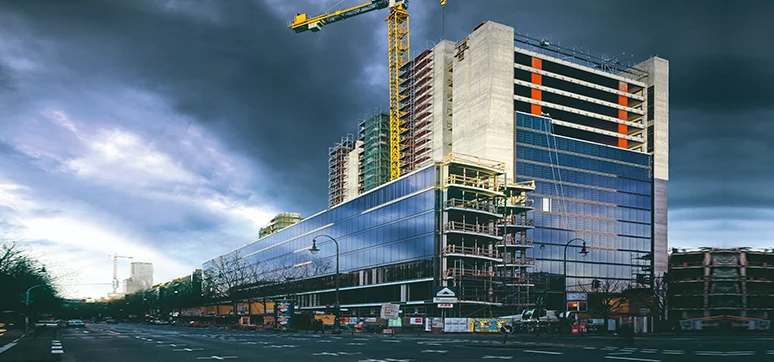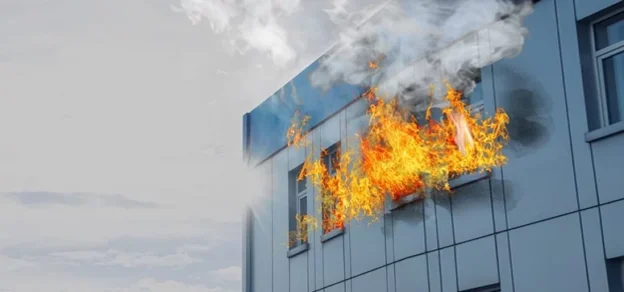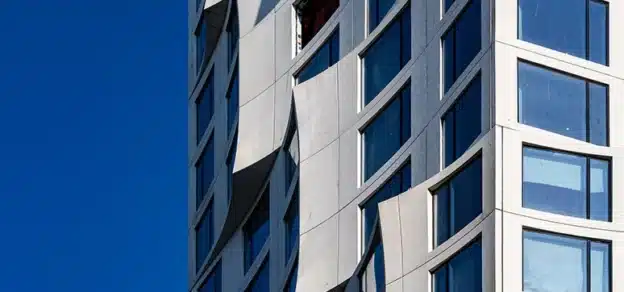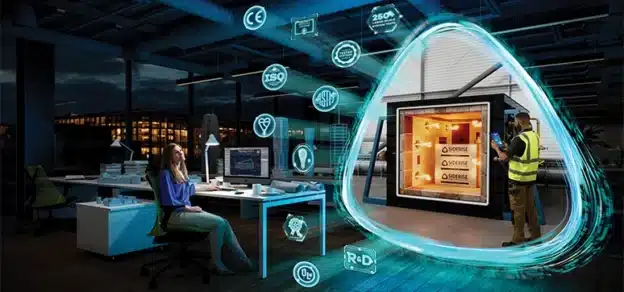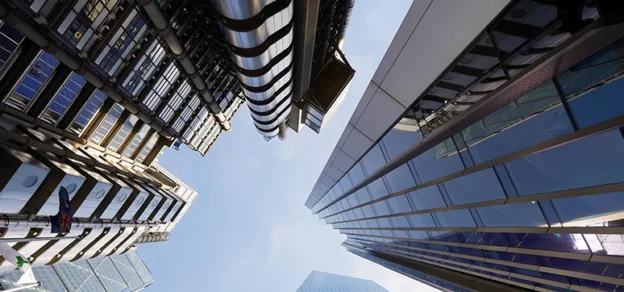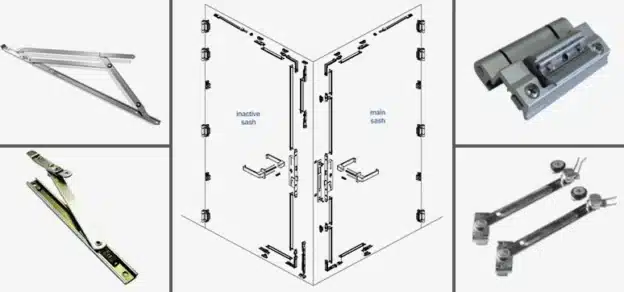One of the dominant features in modern buildings is the ‘curtain wall’, which is a complex amalgamation of components that include spandrel and safing insulation, spandrel glass, vision glass, aluminium frames (transoms & mullions), back pan, anchors, etc. Alongside the external elegant factor, these curtain walls also play a critical role in the energy efficiency and sustainability of the building. But from a safety point, such structures enveloped by a curtain wall system pose an additional challenge to the fire safety of the building.
For the design and construction of curtain wall systems, the building regulatory system and the adoption of various national or international test standards can have a critical impact on the performance of a façade, in case of a fire incident. Avoiding or compromising the edge of the slab opening with no systems or a non-tested system can potentially lead to a catastrophic inferno. Perimeter Fire Barriers (PFBs) are one of the critical systems required by the various national and international building codes and it’s an effective way of restricting the movement of fire and smoke.
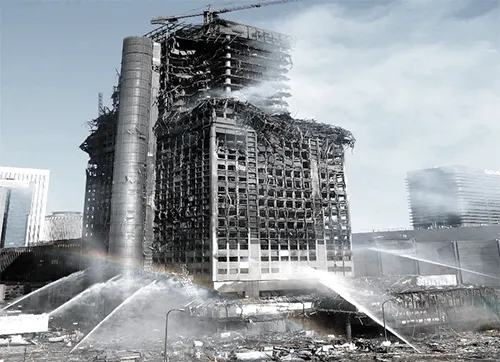
Typically, the path for the fire to spread to adjacent floor levels at the building perimeter is through the ‘chimney effect’ wherein the fire, smoke and hot gases propagates through the void space created between the edge of the floor and an exterior curtain wall and it can be mitigated through appropriate design, installation, inspection, documentation and maintenance of perimeter fire barrier systems.
It is important to recognise that the width of the horizontal gap between the edge of the slab and the curtain wall can vary drastically, especially considering construction tolerances in concrete buildings. This is when the building codes and the relevant standards play a vital role by providing guidance on the need and the methodology of protecting the void between the fire rated floor and an exterior wall in order to effectively mitigate the risk of fire and smoke propagation from one floor to other.
Codes and Standards
For buildings featuring glass façade assembly, NBC 2016, clause 3.4.10.2 b) recommends that all gaps between floor slabs and façade assembly shall be sealed at all levels by approved fire resistant sealant material of equal fire rating as that of the floor slab to prevent fire and smoke propagation from one floor to another. As per UAE fire code clause 3.3.5, Perimeter fire barrier system ratings shall be established in accordance with ASTM E 2307, BS EN 1364-3 (Full configuration test) or BS EN 1364-4 (Part configuration test) or other equivalent tests using the Intermediate-Scale, Multi-Story Test Apparatus (ISMA) as the test method.

Furthermore, NFPA 101, 2018 clause 8.3.5.4.1 mentions that the Voids created between the fire-resistance–rated floor assembly and the exterior curtain wall shall be protected with a perimeter joint system that is designed and tested in accordance with ASTM E2307, Standard Test Method for Determining Fire Resistance of Perimeter Fire Barriers Using Intermediate-Scale, Multistory Apparatus. Similarly, IBC 2015, Section 715.4 states that the void created between the slab edge and the curtain wall must be sealed with an approved system tested per ASTM E2307 that remains securely in place for the time period equal to the fire-resistance rating of the floor assembly.
In general, any void between the fire-rated floor and an exterior wall must be protected using a perimeter fire containment system that has been tested in accordance with ASTM E 2307 – ‘Standard Test Method for Determining Fire Resistance of Perimeter Fire Barriers Using Intermediate-Scale, Multistory Test Apparatus (ISMA). And for evaluating the air leakage (smoke rating) of perimeter joints, ‘UL 2079 – Tests for Fire Resistance of Building Joint systems’ is referred to.
Tested Systems, Ratings and Engineering Judgements (EJ’s)
The basic configuration of the test furnace and test sample in ASTM E 2307 includes a two-story building with the ground floor fully engaged in a post-flashover fire condition. The fire is provided using two burners, one internal burner placed inside the structure and one external burner placed outside the structure, providing a flame plume up along the side of the building. An exterior curtain wall is then installed on one side of the structure. The void between the curtain wall and the edge of the floor slab is then protected with materials that are intended to prevent the passage of flames through the void and based on the testing the ‘F-Rating (Fire Rating)’ and ‘T-Rating (Insulation rating)’ for the assembly is established.
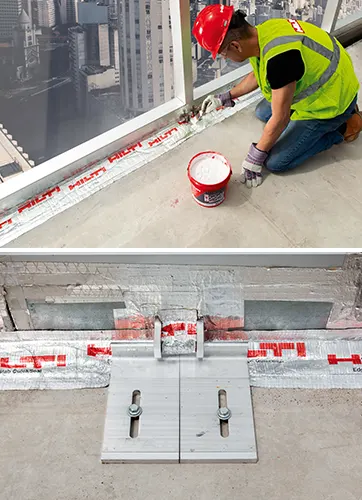
To be considered a dynamic perimeter joint protection, both expansion/ contraction and shear movements must be cyclic tested. The cyclic movement demonstrates the perimeter joint protection’s ability to move in expansion/contraction responding to environmental forces (wind, thermal, and seismic) and how they move in shear in reacting to live loads while maintaining a seal between the floor assembly and exterior wall assembly and resisting fatigue and degradation. The cyclic rate, magnitude, and duration of movement can also affect the performance of the perimeter joint protection when subjected to standardised fire exposure and ASTM E2307 provides test conditions for these variables.
When field conditions differ from the original design (Eg.: variation in gap width, arrangement of Spandrel assembly, etc.) or unanticipated construction hindrances are encountered, Engineering Judgments (EJ’s) are typically made that recommend alternative methods to ensure the performance of the firestop system is not compromised. Generally, these conditions or hindrances cannot be effectively redesigned so alternative recommendations are to be provided based upon identical designs as that which were fire tested, it is important that they be developed using sound engineering principles and has to be provided by the trained and qualified personnel based on the recommendations prescribed in IFC guidelines.
Tested System Design
In order to choose a right system, it is important to know the basic details of the application such as the makeup of the exterior wall – Spandrel Glass, Aluminum Panel etc., hourly rating, joint width, static or Dynamic joint etc. The right system selection for a perimeter firestop system can be done by accessing third-party certification laboratory listing directories. The UL and Intertek listings represent an enormous amount of successful fire containment understanding. The UL & Intertek directory follows a specific nomenclature to identify the different firestop systems listed based on which right system can be chosen to suit the specific needs of the project.
For example, UL certifications for Perimeter joints use a unique numbering system. The systems are identified in this category by an alpha-alphanumeric identification system. The first two alpha characters, CW, identify the perimeter-fire containment system as being for use at the interface of a fire-rated floor and a non-fire-rated exterior curtain wall. The third alpha character is either S or D. The S signifies perimeter-fire containment systems that do not have movement capabilities (i.e., Static). The D signifies fire-containment systems that do have movement capabilities (i.e., Dynamic).
The numeric component uses sequential numbers to identify the maximum clearance distance between the curtain wall and the perimeter of the floor. The significance of the number used is:
To choose a system, we need to know the basic details of the application.
- The makeup of the exterior wall – Concrete panel, Spandrel Glass, Aluminum Panel, etc.
- Supports the exterior wall – Steel stud, aluminum mullions etc.
- Hourly rating requirement – F rating (1 – 2 hour)
- Smoke rating requirement – L rating (<.1 SCFM/LF)
- Joint width – Measured from edge of slab to nearest point of curtain wall
- Movement requirement – Must accommodate building movement (% of joint size)
- Special considerations, if any – Unique construction condition, environmental exposure
Upon successful completion of testing of fire barrier system by UL or Intertek Laboratories, the systems are judged eligible to bear UL Mark or ETL mark respectively. Furthermore, the certified systems are subjected to Follow up Service(FUS) as a part of a surveillance program post-certification to verify that the product still meets the original requirements it was certified under. Throughout the lifetime of a UL Certification, they conduct regular inspections of production facilities and products, with an end goal of total compliance.
Perimeter Fire Barrier Installation Typically, Firestop manufacturers will have their own programs and qualification criteria for installers wherein they educate and train them on the trade-specific installation methodologies. Since perimeter fire barrier systems are ‘Listed’ systems, they must be installed in accordance with their listing and the manufacturer’s installation instructions.

The most critical points that are required to be considered for ensuring the effective functioning of the perimeter Fire barrier system include the following aspects:
- Is the rating of the perimeter fire barrier system equal to or greater than the floor it is adjacent to?
- Is the EOS joint system tested and listed by an accredited lab?
- Is the installation done by the trained and qualified installer?
- Is EJ made available in case of non availability of the tested system exactly matching the actual site condition
- Does the field installation follow the listing w.r.t width of the gap between floor edge and curtain wall, curtain wall spandrel insulation (type, thickness, density, etc.), safing insulation (type, depth, % of compression), etc
- Are the details of the installed system documented in an appropriate manner to enable the Inspections and maintenance of the Firestop system.
Conclusion
It is important to have the ‘Fire Barrier System’ appropriately designed, installed, inspected, documented and maintained for serving its intended use. The system shall bear the design ‘Listing’ and ‘approval’ label and conform to the construction type, joint gap and fire, smoke and movement rating requirements of each separate assembly. It is the responsibility of the product manufacturer/supplier to provide a formal submittal consisting of system design listing or test certifications, including illustrations, from an accredited testing laboratory as per referenced standards that are applicable to each system configuration.
Adherence to code requirements ensures safety and peace of mind for the builders, contractors, architects, inspectors and occupants. In addition, it helps the fire fighters to carry out firefighting and rescue operations thereby enable to save lives and protect assets.
